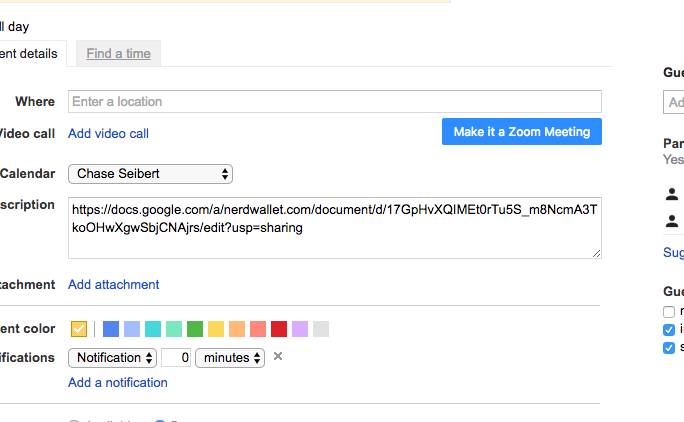Best Practices for Meetings
Every team meeting needs a primary owner. If you are the owner of the meeting, it’s your responsibility to make sure that this is a great use of team time.
This only applies to team meetings with 3+ people, not 1:1s.
Before the Meeting
Make attendance optional
Not everyone needs to go to every meeting. If you’re using Google Calendar, when you invite a team, expand the group into individuals and click on the person icon to the left of a name to mark that attendee optional.

Write an agenda
Any meeting with more than a couple of people should have a written agenda on the calendar item itself. Have some standard meeting agendas that the team agreed on. Part of the agenda is how much time you want to allocate to each topic. The entire allotted time for agenda items should be at least 5 minutes less than the block of time for the meeting. The written agenda should be on the meeting at least the day before.
It’s perfectly reasonable to decline attending a meeting if you’ve asked for an agenda, and there is still not a written agenda.
Share out pre-Reading
As part of the agenda, share out and reading materials ahead of time. You should not spend a lot of time during a meeting reading slides; the meeting should be for getting feedback and discussion of the content.
Setup remote access
If you use Zoom.us for remote meeting access, meeting owners are responsible for setting up Zoom for all meetings. You never know when someone is going to be remote that day. You can use the Zoom Chrome plugin to quickly create Zoom info. This will allow attendees to dial in before the meeting even starts.

During the Meeting
Get there early
Meeting owners should get to the room a few minutes ahead of time to make sure that Zoom and screen sharing it setup and working. You should not be making attendees wait around for this to happen. This will sometimes necessitate that meeting owners leave a previous meeting 5 minutes early. If you own a meeting, that’s part of your responsibility.
Start on time
Start the meeting on time. Don’t wait for stragglers, get right into it. If people show up late, it’s their responsibility to try to catch up.
Take notes
Either the meeting owner or someone they delegate to should be taking notes for the meeting. These can be on a wiki, a Google doc, or directly in an email.
Timebox discussions
It’s the meeting owner’s responsibility to keep the meeting on track. If the amount of time you have allocated for a specific discussion is going over, you may have to cut it off.
- Keep discussions on topic
- Feel free to put items “in the parking lot” to discuss later/offline
- Move on to the next agenda item when time is up
Follow the agenda
Don’t get side tracked by discussion that was not on the agenda. Alternatively, you can edit the agenda in real time if you believe the new discussion is more valuable than an existing agenda item. But be conscious about which agenda items are being removed, and call that out in real time to the team.
Ask for feedback
Before the meeting ends, take 2 minutes to do a +/-/Delta exercise with the group.
- Write +, - and Delta on the white board as categories
- Ask the group what they liked about the meeting and put it under the + column
- Ask the group what they did not like about the meeting and put it under the - column
- Ask the group what they would change about the meeting and put it under the Delta column
End on time
End meetings promptly. Give attendees 5 minutes to get to their next meeting.
After the Meeting
Send action items
Send both the meeting notes and the action items out to the attendees as an email. Action items have a specific person assigned to them, and detail the next action to take to make progress on that issue.
